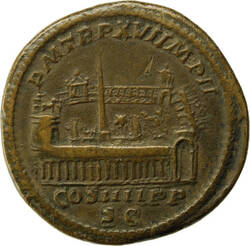Bronze sesterces were comparatively large and so offered the emperors more scope for self-promotion than other coins. That made them especially suitable for publicising achievements, slogans and programmes. Emperor Caracalla, hated by the senate but popular with ordinary citizens, had this sesterce minted in 213 AD.
The reverse features an image of the Circus Maximus, and it's incredibly detailed. The Circus Maximus was the venue where chariot races were held in ancient Rome. It held 150,000 spectators and was 600 metres long and 140 metres wide.
We're seeing it from the emperor's point of view, as it were. It's as if he's looking down on the complex from the palaces that stood on the Palatine – one of the seven hills of Rome. You can make out a row of arcades at the front, ending in a tall arch. At the back is the stand for the spectators, with the temple of the sun god Sol to the left and a large statue on the right. On the long sides, you see – on the left – a triumphal arch erected by Emperor Titus with a chariot and four on top, and on the right the starting gates.
The obelisk in the centre dominates the view. It had originally been brought to Rome from Egypt by the Emperor Augustus. On either side of the obelisk you can identify the two conical turn markers for the chariot races. If you look really closely, you can even see that the chariots have left their starting positions and are off!
Emperor Caracalla was a passionate fan of chariot racing. He even had his own particular favourites among the charioteers. The image on the sesterce was intended as a reminder that the emperor was carrying out a series of structural measures designed to extend the Circus Maximus.
Further Media
- Location & Dating
- Rome (Roma), 213
- Material & Technique
- Bronze, embossed
- Dimenions
- Durchmesser: 33,7 mm, Gewicht: 22,63 g
- Museum
- Münzkabinett
- Inventory number
- ACC3233
